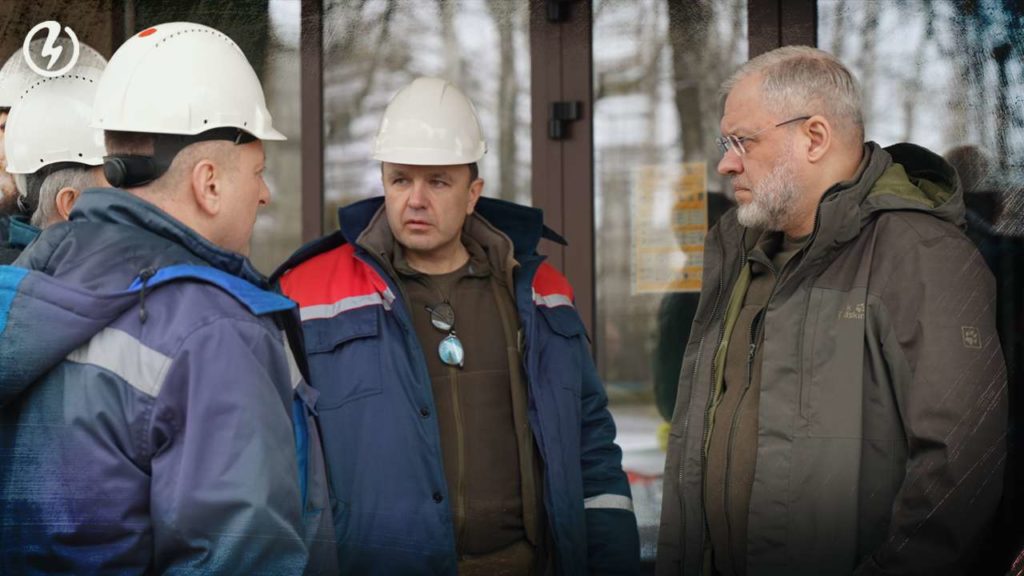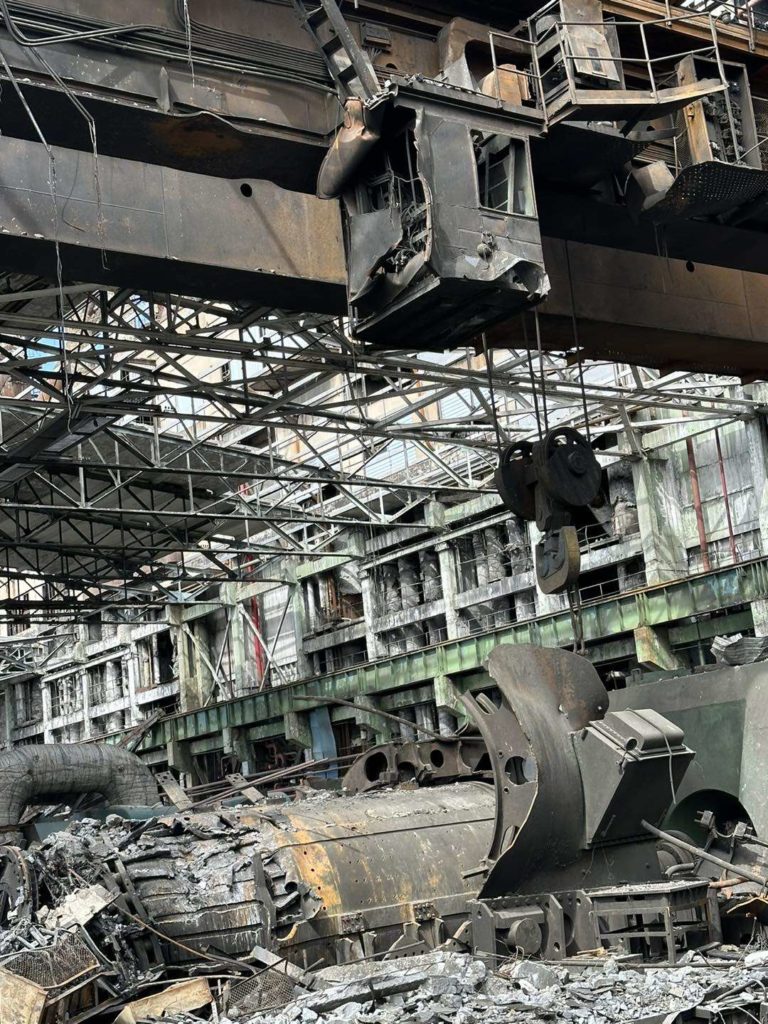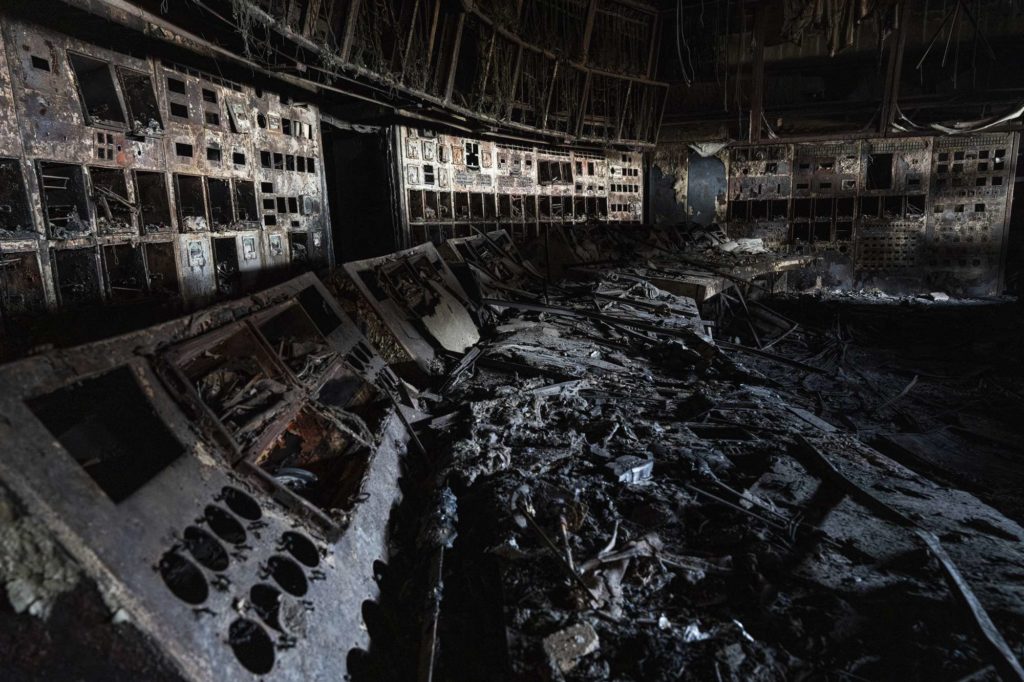As spring arrives in war-torn Ukraine, a familiar dread settles over the nation: the looming specter of blackouts. For the third year running, Russia has unleashed a blitzkrieg of missiles and drones against Ukraine’s power grid, aiming to plunge its defiant neighbor into darkness.
Ukraine went from energy exporter to energy importer overnight
This time, the damage is severe. Despite being battered by three years of Russian strikes, Ukraine managed to export electricity to the EU, with peak values reaching 700MW.
This changed overnight on 22 March 2024, as Russia attacked objects of Ukraine’s power grid throughout the country. Ukraine’s electricity deficit reaches 2GW and Ukraine has started importing power just to keep the lights on, says energy expert Oleksandr Dombrovskyi.
Russia used their regular tactic: first, waves of drones, then cruise missiles to overwhelm Ukraine’s air defense. After this, ballistic missiles that Ukraine lacks capacity to shoot down.
This was the largest attack on Ukraine’s power grid during all its war, Ukraine’s energy minister Herman Halushchenko said. 60 drones and 90 missiles of various kinds were fired.
Ukraine’s second-largest city, Kharkiv, and Kharkiv Oblast were badly hit: a major thermal power plant and a cogenerating thermal plant that produced heat and electricity were fully destroyed. The region now faces regular blackouts. Thermal power plants in western Ukraine were also damaged, as was the Dnipro hydropower plant in Zaporizhzhia, which was critically damaged.
A fire breaks out at Trypilska power plant following a Russian 11 April missile attack. Photo: Centrenergo, operator of the plant
On 29 March, the attack was followed by 60 more drones and roughly 40 missiles. Generating capacities in central and west Ukraine were hit, including two hydropower plants.
On 11 April, Russia sent 40 more drones and 42 missiles, including six ballistic Kinzhals and five new Kh-69 cruise missiles, into the power grid objects throughout Ukraine. The attack destroyed the largest power producer near Ukraine’s capital. It could be repaired with the help of western partners – but this task is futile if Ukraine’s air defense is not strengthened, power company Centrenergo said.
Damage to Ukraine’s power grid worse than in the winter of 2022-2023
Minister Halushchenko believes Russia’s goal is unchanged since the start of the war: to cause a total blackout in Ukraine.
In the winter of 2022, Russia used the same tactics, energy expert Mykhailo Honchar told Euromaidan Press. They thought they would manage to destroy the grid, but Ukraine turned out to be more resilient. Now, Russia continues with its overarching goal, accumulating stocks of missiles and drones for large-scale attacks.

That winter, Ukraine was plagued by blackouts. Russia steadily pounded the power grid with missiles, attempting to cause a total energy collapse amid the freezing weather. It conducted 15 missile and 18 drone attacks at Ukraine’s energy infrastructure, launching around 1,200 missiles and drones. 200 of them hit their targets; 50% of power stations and over 40% of power lines on Ukraine’s territory were significantly damaged.
Despite apocalyptic predictions, Ukraine withstood with remarkable resilience and managed to partially rebuild its energy infrastructure.
In 2024, warm weather, imports from the EU, and power cuts to the most affected regions – Kharkiv, Dnipropetrovsk, and Odesa oblasts – have prevented the nationwide blackouts of the previous winter.
However, they could become a reality as soon as Ukraine’s power consumption rises closer to summer, when cooling is need, and as winter comes. Some experts believe blackouts are inevitable, as summer is the time when units of Ukraine’s nuclear plants will be shut down for planned repairs, further dropping Ukraine’s generating capacities.
A new strategy to knockout Ukraine’s energy
The devastation is much worse than in 2023. Russia changed its attack tactics: it used high-precision missiles to destroy power plants in regions much less protected than capital Kyiv.
Last year, Russia also targeted power grid objects that are important for balancing consumption.
However, this year, the tactics have changed: instead of carpet bombing all the objects, Russia concentrates them on specific regions, attempting to cut off large cities and industrial regions in Ukraine’s east from power consumption, says the communications director at Ukraine’s national power operator Ukrenergo Maria Tsaturian.

It also targets Ukraine’s westernmost regions, aiming to disconnect Ukraine from the EU’s power system, which it joined in the early days of Russia’s invasion in 2022, she added.
Ukraine’s state fuel operator Naftogaz stated that the 11 April attack targeted the aboveground infrastructure of Ukraine’s underground gas storage facilities, where both Ukraine and its partners store gas. The company stressed that the facilities “continue operating” and that experts were dealing with the consequences of the attacks.
The aim of this attack is not only to complicate Ukraine’s preparations for winter but also to also to dissuade the EU from using Ukraine’s underground gas storage, as said by energy expert Olena Pavlenko.
This storage, the largest in Europe, helped address an energy crisis in the EU in the winter of 2023-2024, helping to keep gas prices low amid Russian manipulations by tapping from Ukraine’s giant gas reserves.
These underground storage facilities, built during Soviet times with the aim of getting Europe on the Kremlin’s gas needle, now serve the opposite purpose, proofing the EU against Russian-induced price spikes. They also allow Ukraine to earn money, crucially needed amid Russia’s war.
This is precisely the reason Russia targets them: to destroy Ukraine’s economy, believes Anna Ackerman, an analyst at the Institute for Sustainable Development.
Air defense and levels of protection for Ukraine’s energy infrastructure
Why was the damage so bad this year? Ukraine simply lacks enough air defense units to protect all its strategic objects, believes Mykhailo Samus, deputy Director at the Army Research, Conversion, and Disarmament Center.
Air defense has become Ukraine’s number one task in the wake of the attacks. Ukrainian Foreign Minister Kuleba made it the focal point of Ukraine’s requests at the NATO summit on 4 April. This has so far resulted in Germany announcing the donation of one additional Patriot air defense system to Ukraine – a key asset allowing to intercept ballistic missiles.
A destroyed DTEK power plant following a Russian missile attack in Ukraine on 2 April 2024. Russia is attacking Ukraine’s energy sector with renewed intensity and alarming accuracy, signaling to Ukrainian officials that Russia is armed with better intelligence and fresh tactics in its campaign to annihilate the country’s power generation capacity. (AP Photo/Evgeniy Maloletka)
However, many more are needed. President Zelenskyy mentioned 25 Patriot batteries. This number would be incredible, says Mykhailo Samus. However, given the realities, the bare minimum at least 5-7.
“As well, it is important to also saturate the radar system, which should fully cover both the territory of Ukraine and at least 200 kilometers deep into Russian territory,” Samus adds.
One reason the strikes have succeeded now is Ukraine’s lack of ammunition, including for air defense missiles, which is exacerbated by a holdup of a Ukraine aid package in the US Congress.
“The Russians believe they have a window opportunity on the front and in missile strikes: the lack of American support objectively undermines the capacities of Ukraine’s Armed Forces,” Samus says.
Ukraine has built protective structures around its power grid following last winter’s strikes. Ukrainian officials and experts generally speak of three levels of protection:
- Gabions – rock cages that can protect small energy objects from shards after a strike;
- Drone nets, which allow catching Iranian-designed Shahed kamikaze UAVs launched by Russia. According to Ukraine’s Deputy Reconstruction Minister Oleksandr Kubrakov, 22 key power substations are protected with such nets;
- Air defense – only it can protect large objects such as power stations; they are simply too large to be protected with defensive structures.

Director of the Center for Energy Studies Oleksandr Kharchenko says that Ukraine installed gabions and drone nets on 20-25% of its high-voltage substations, which suffered the most in Russia’s last-year attacks. These worked relatively well in the latest attack, repelling multiple attacks, but there were not enough. Moreover, no physical protection will withstand a direct hit from a high-precision ballistic missile, he adds.
Additionally, there is a plan to move things underground.
Deputy Minister Kubrakov informs that Ukraine is working on a project to fully protect its key 22 substations from Russian attacks by building new units in bunkers capable of withstanding missile strikes. Ukraine has started construction on this project with four partner countries – the UK, USA, Germany, and Japan, but needs more funds to continue.
How much of Ukraine’s power grid was damaged?
The exact extent of damage to the power grid is unknown.
Oleksandr Kharchenko estimates that Ukraine lost 70-75% of its thermal power production and 35-40% of hydro production.
Ukraine will need to race to repair 25-30% of thermal generation before winter, he believes.
Another expert, Oleksandr Holizdra, believes that Ukraine lost 2-6 GW of its total production capacity out of an overall capacity of 16-17 GW.
Ukraine’s largest commercial power company DTEK, which owns the lion’s share of thermal power plants in Ukraine, lost 80% of its energy production just in the first two attacks. In some cases, generating blocks must be rebuilt from scratch, DTEK CEO Dmytro Sakharuk said.

DTEK will be unable to rebuild it capacities without donor costs: $200 mn worth of large equipment was destroyed only in the first two attacks. However, this exercise is pointless without strengthening air defense: two-thirds of all the infrastructure rebuilt from last year’s attacks is now destroyed again, according to Sakharuk.
Centrenergo, a power company servicing the capital Kyiv, lost 100% of all its generating capacities as its thermal power plants were destroyed. Theoretically, they could be repaired if Ukraine could get the spare parts from Western partners. However, the company stresses the need for air defense: there is little sense in rebuilding if Russia will attack the repaired station again.
Crucially, some of the destroyed thermal plants were cogenerating — producing heat simultaneously with electricity. These are especially important to repair, as it is much harder to survive without heat during the winter than without power.
What if the strikes continue?
Most likely, Ukraine will retain a baseline of power production but will need to resort to blackouts.
This is because over half of Ukraine’s power production comes from nuclear plants, which Russia has not targeted in its attacks, either fearing a nuclear accident or due to their extensive protection.
The objects that Russia did hit, thermal and hydropower plants, can quickly provide electricity during peak hours and whenever else it is needed. If Russia continues their destruction, Ukraine will be forced to introduce nationwide rolling blackouts, dealing a blow to industry production and Ukraine’s fragile wartime revenues.
Ukraine’s Main Intelligence Directorate (HUR) believes that Russia has enough missiles for several more mass strikes on Ukraine’s power grid.
HUR deputy director Vadym Skibitskyi said Russia still has 950 high-precision missiles with a range of over 350 kilometers. Skibitskyi says Russia tries to keep its missile stocks at a minimum of 900 missiles; when it has more, it launches large-scale attacks. When the stocks approach 900, it pauses until more are produced.
In April, Russia plans to make roughly 40 Kh-101 missiles, enough for 2-3 mass attacks, Skibitskyi believed, after the second wave of attacks on 29 March. After that, it will need to take a pause to accumulate missiles and drones.
While Russia claimed the strikes were a tit-for-tat measure in response to Ukraine’s drone attacks on its oil refineries, that is unrealistic, says Maria Tsaturian. The strikes were well-prepared in advance, tailored to specific objects.
The goal remains unchanged since the start of the war: a full collapse of Ukraine’s power grid, and Russia attempts to finish off what it could not achieve in 2022-2023, Tsaturian says.
A race to repair ahead of winter and the need for a new decentralized power production strategy
Repairs to Ukraine’s energy infrastructure damaged by Russia is an ongoing process since the start of the war in 2022, says Ukraine’s Deputy Energy Minister Svitlana Hrynchuk.
According to Ms. Hrynchuk, Ukraine’s number one task is to repair and rebuild what can be rebuilt as soon as possible. Not only transformers but also generating capacities need repairs.

Ukraine will need to import turbines for generating – and it is very important that its partners temporarily waive green energy requirements, says Olena Pavlenko from Dixi Group: simply regaining Ukraine’s lost coal power capacities to avoid an energy collapse ahead of the next winter will be a race.
The second track is to continue transforming Ukraine’s power grid away from large-scale production capacities into a more decentralized and green power generation setup which would be less vulnerable to attacks.
However, the latter is a task that will take many years of planning and construction. What can help Ukraine in the timeframe of two-three years is distributed natural gas-based power generation, energy expert Oleksandr Kharchenko believes. Small-scale gas piston and gas turbine power plants are less vulnerable to enemy attacks.
Kharchenko estimates that Ukraine needs to install at least 2-2.5 GW of new power generation capacity to compensate for the recent losses caused by attacks on the country’s energy infrastructure.
However, one first attempt at decentralized gas-based generation has reportedly gone awry.
In February 2023, America’s USAID agency donated a 28 MW General Electric gas turbine mobile power plant to Ukraine’s state-owned Energoatom to help weather blackouts after a winter of Russian energy terror. USAID planned to provide more after the successful implementation of this pilot project. More than a year later, the plant is still not operational amid questions about the high costs of a local contractor and a lack of key installation equipment.

Another quick solution Ukraine is pursuing is installing solar panels on critical infrastructure objects such as hospitals, Deputy Energy Minister Hrynchuk says. These could start working before the next heating season. There are plans for small nuclear reactors, but installing these will take years.
Yet another prospective solution, according to Hrynchuk, is to expand the existing reactors at Ukraine’s nuclear power plants: according to her, Ukraine needs a “base energy” source, as its climate does not allow prioritizing renewables.
State power operator Ukrenergo has unveiled its strategy to protect Ukraine’s power generation against Russian strikes: building hundreds of small power plants, which will disperse generation throughout Ukraine and thus make it less vulnerable to attacks.
Related:








